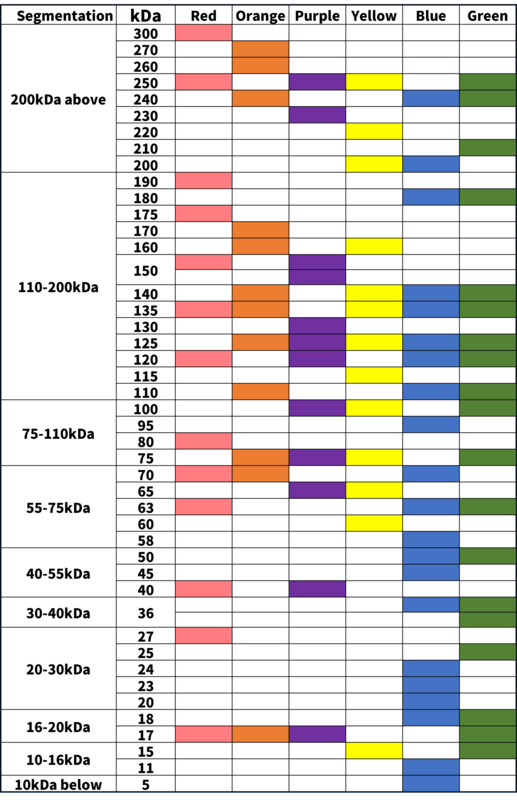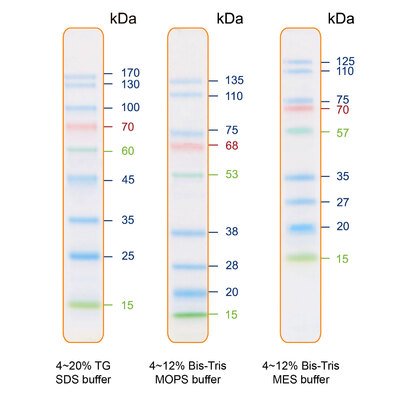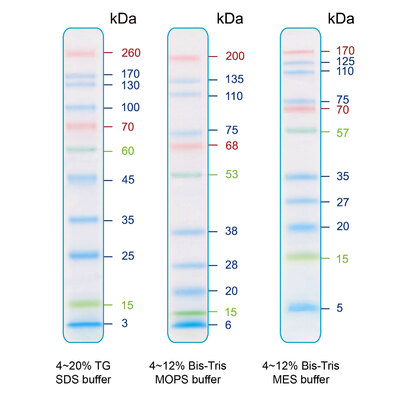
BIO-HELIX - PMC
Customized Prestained Protein Ladder
Size: Customization
 Try to create your own and unique prestained protein ladder now.
Try to create your own and unique prestained protein ladder now.
With over a decade of expertise in developing, manufacturing, and supplying bio-reagents for laboratory research, Bio-Helix’s products have been playing a key role in advancing research in both genomic and proteomic fields. For further enriching and diversifying the current protein ladder portfolio, we are pleased to launch the protein ladder customization service and make it widely available to the existing and new clients worldwide.

1. Uniquely tailor-made Prestained or Unstained Protein Ladder according to one’s specifications.
2. Minimized Entry Volume Requirement – 500ml to 10 liters, with 3 to 12 protein bands and 1 to 6 color selections
3. All available proteins were sorted by molecular weight (from high to low) and divided into ten regions. We recommend selecting one protein from each region to create a customized marker. This ensures an even distribution across the gel and well-separated bands.
It shows we could pick any band you prefer to make your own ladder.
The second pic shows we could stain one protein with the color you prefer, up to 9 colors.
Application
Designed for monitoring protein separation during SDS-polyacrylamide gel electrophoresis and verifying Western transfer efficiency on membranes (PVDF, nylon, or nitrocellulose) and for approximating the size of proteins.
》Consistency Is Key
Protein mobility can vary between laboratories and instruments due to factors such as gel concentration, buffer system, SDS purity, running voltage/current, and gel casting method.
》Establish a Golden Standard
You must establish a Golden Standard protocol within your facility or adopt the one we provide as your internal reference. This standard is essential to explain any observed differences in marker band positions.
》Use of Commercial Benchmarks
If you assign your own molecular weights, they should be aligned by comparing your marker with an established industry standard (e.g., Thermo, Bio-Rad, NEB, etc.). Use either prestained or unstained markers to determine relative band migration and assign approximate molecular weights (MWs) accordingly.
》Important Clarification to Users
The molecular weights of prestained protein markers are estimated values based on relative mobility, not absolute molecular sizes. Every manufacturer may show slight variations due to system differences. This must be clearly communicated in all technical documentation.
| Buffer System | Type | Molecular Weight Range | pH Range | Key Features | Recommended Applications |
|---|---|---|---|---|---|
| Tris-Glycine | SDS-PAGE | ~25–250 kDa | ~8.3 | Widely used; cost-effective; suitable for general applications | Standard SDS-PAGE; broad protein analysis |
| Tris-Tricine | SDS-PAGE | <30 kDa | ~8.3 | High resolution for small proteins and peptides | Low MW proteins; peptides |
| Tris-Acetate | SDS-PAGE | >200 kDa | ~7.0 | Efficient for high MW proteins; prevents aggregation at the gel bottom | High MW protein separation |
| MES (Bis-Tris) | SDS-PAGE | 2–60 kDa | 6.1–7.5 | High resolution for small proteins; fast run time | Low MW proteins using commercial Bis-Tris gels |
| MOPS (Bis-Tris) | SDS-PAGE | 14–200 kDa | 6.5–7.9 | Ideal for mid-to-high MW proteins; sharp bands and stability | General use with Bis-Tris commercial gels |
| HEPES (Bis-Tris) | SDS or Native PAGE | ~10–250 kDa | 6.8–8.2 | Mild buffering; maintains protein activity; stable at 37°C | Native PAGE; enzyme activity analysis |
| Native Tris-Glycine | Native PAGE | Variable | ~8.3 | Maintains native protein structure; no SDS | Functional studies; protein complexes |

| Name | Download |
|---|---|
| Bio-Helix_Customized Ladder_Protocol | Bio-Helix_Customized_Ladder_Protocol_V1_20220221.pdf |



